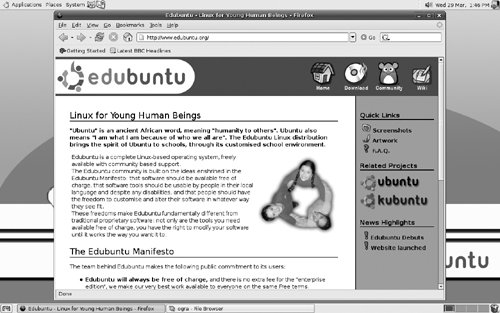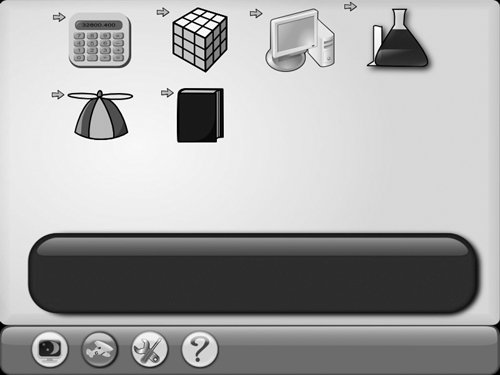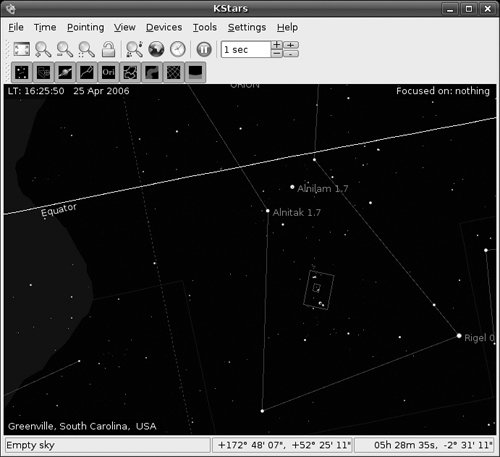Partner Projects
| Partner projects are those projects that work in close relation with Ubuntu. All partner projects are officially supported by Canonical Ltd. Partner projects also share a common repository of packages and release in sync with Ubuntu. KubuntuKubuntu is the first and oldest of all the partner projects. First released alongside Ubuntu 5.04 (Hoary Hedgehog), Kubuntu, which means "toward humanity" in Bemba, builds on the strengths of the K desktop environment (KDE) rather than GNOME as Ubuntu does. The project is led by Jonathan Riddell, who now works for Canonical Ltd. As with Ubuntu, Kubuntu is a complete desktop but one built around KDE and QT. Rather than Ubuntu's brown theme, Kubuntu opts for a more traditional blue and makes a few other visual changes. Rather than the two panels and three menus of Ubuntu with GNOME, Kubuntu uses two menus and a single lower panel, closer in style to that of Microsoft Windows. Kubuntu also comes with OpenOffice.org, the same Office suite that is included in Ubuntu. Along with this office suite, Kubuntu also includes Krita, a photo manipulation tool, the K3b CD Kreator, and the media player amaroK, all parts of KDE. Kubuntu is explored in much more depth in Chapter 7 so is not given a full treatment here. TIP: Kubuntu Kubuntu can be found at www.kubuntu.org EdubuntuAs the name implies, Edubuntu is a version of Ubuntu for use in schools and other educational environments. Edubuntu uses Linux Terminal Server Project's (LTSP) thin client technology as well as a number of programs aimed at the educational market such as Gcompris and the KDE Education suite. Oliver Grawert, a Canonical Ltd. employee, leads the Edubuntu development. Like Ubuntu, Edubuntu uses the GNOME desktop environment. The default desktop is show in Figure 9-1. Figure 9-1. Default desktop. One of Edubuntu's unique features is the inclusion of the LTSP in an easy-to-use, out-of-the-box installer. LTSP uses a different methodology of deploying clients over a network than in traditional computer deployments. Instead of full-blown computers, LTSP uses thin clients, computers that connect to a larger server to do all the processing work. In larger deployments it is often more cost effective to have a few more powerful servers serving applications to less powerful thin clients than to have a collection of medium-speed computers doing their own processing. Since the thin client ends up being a glorified display, LTSP has become a common use for older machines that are typically not powerful enough to run a full OS. It is common for deployments to remove the hard disks from these machines, which can also result in much quieter computers. Since these clients use the standard X11 protocol, many independent vendors also sell thin clients built just for this purpose. Oliver Grawert has worked with members of the LTSP community with the intention of making the Edubuntu version easy to set up and administer. A teacher with moderate technical skill could easily set up an entire classroom of Edubuntu in under an hour. Additionally, Edubuntu is unlike standard Ubuntu in its inclusion of educational games and activities. For younger children, Gcompris (French Internet slang for "'I understand") offers a large and growing number of games and activities such as learning how to use the mouse and type, reading, geography, and mathematics, (see Figure 9-2). Figure 9-2. Gcompris. Edubuntu also includes the KDE Education suite, aimed at a wider age range of 3 to 18. Some notable programs include the planetarium program KStars, the periodic table program Kalzium (see Figure 9-3), and KEduca, a program to create and give tests. There are also a number of programs to help with learning languages and mathematics. Figure 9-3. KStars. TIP: Edubuntu Edubuntu can be found at www.edubuntu.org |
EAN: 2147483647
Pages: 133
- Challenging the Unpredictable: Changeable Order Management Systems
- The Second Wave ERP Market: An Australian Viewpoint
- Enterprise Application Integration: New Solutions for a Solved Problem or a Challenging Research Field?
- Context Management of ERP Processes in Virtual Communities
- Intrinsic and Contextual Data Quality: The Effect of Media and Personal Involvement